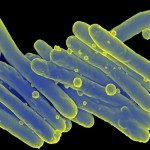Link to Pubmed [PMID] – 19602151
Mol. Microbiol. 2009 Aug;73(3):325-8
The human pathogen Mycobacterium tuberculosis harbours a large number of genes that encode proteins whose N-termini contain the characteristic motifs Pro-Glu (PE) or Pro-Pro-Glu (PPE). A subgroup of the PE proteins contains polymorphic GC-rich sequences (PGRS), while a subgroup of the PPE proteins contains major polymorphic tandem repeats (MPTR). The function of most of these proteins remains unknown. However, in this issue of Molecular Microbiology, Abdallah and colleagues show that PE_PGRS proteins from the model organism Mycobacterium marinum are secreted by components of the ESX-5 system that belongs to the recently defined type VII secretion systems. These observations, which now need to be addressed and confirmed in M. tuberculosis, open new perspectives on the function of these highly abundant proteins.

